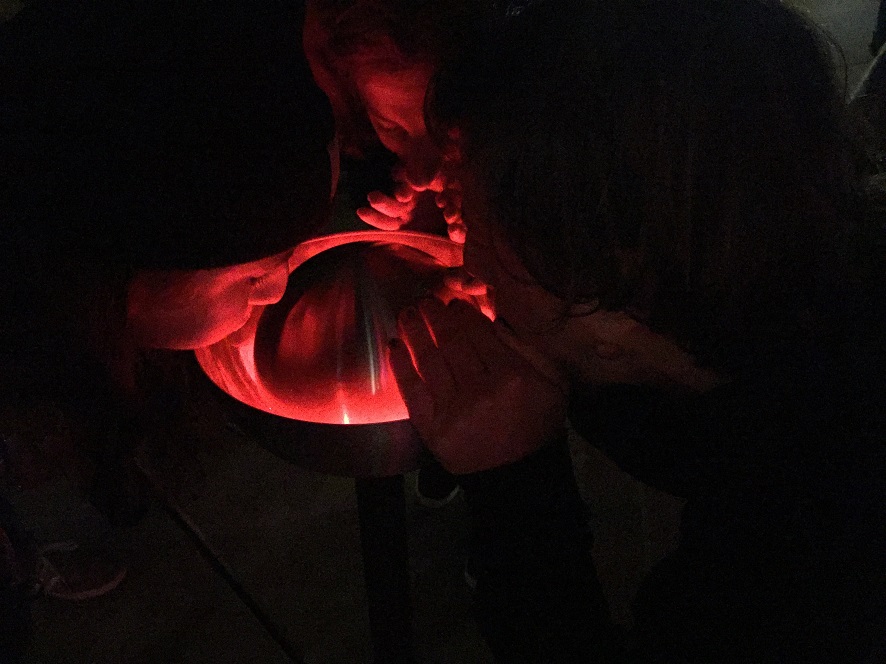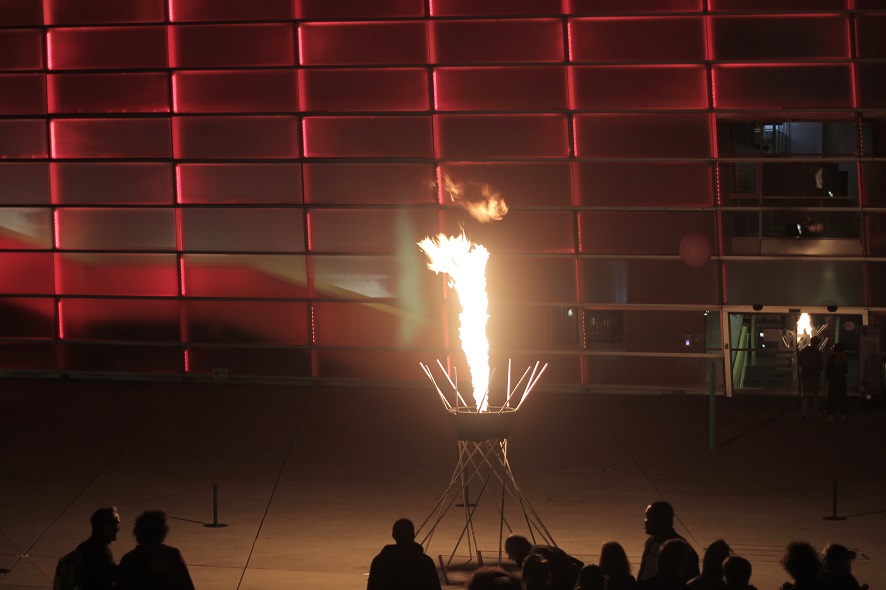The Ars Electronica Center’s colorfully illuminated façade is a familiar highlight of the Linz cityscape throughout the year. But the fascinating bright-red hues that adorned the Ars Electronica Center’s outer shell during the 2015 Ars Electronica Festival—colorings produced and maintained by visitors’ breathing—was the outcome of two artists’ extraordinary idea. “Flame,” a work by Tamer Aslan & Onur Sönmez, symbolizes the significance society traditionally ascribes to the element of fire.
An effort to exhale breath collectively is meant to enable people to experience the lost meaning of the allegory. Making people cognizant of their own power via this collaborative act is the central element of an installation that utilizes the modern means of media façade art to get across ancient, time-honored values. In this talk with Tamer Aslan, we learned what motivated this idea’s gestation and the significance of allegory for the here & now.
If the fire in your installation stands for the power a people uses to make something happen, then what does breath represent in this symbolic construction?
Tamer Aslan: Breath symbolically asserts that people have to give of themselves and make a concerted effort to regain the power they’ve relinquished.
What has led you to conclude that, with the loss of fire, people have ceded control or the power to change things to other institutions? When exactly did this happen, and is this assessment still valid considering that, at this very moment, people are taking to the streets to show where they stand on the refugee question?
Tamer Aslan: The concept of “power” doesn’t refer solely to political power; it also encompasses the meaning in classical mythology. Prometheus gave fire to humankind because he saw that people were living on the same level as wild animals. They couldn’t cook food, or wash and warm themselves. So Prometheus stole fire from Zeus and gave it to humankind. The metaphor is more a reference to the question of whether it’s possible for humankind to use the means we have at our disposal or whether this is prohibited.

The “Flame-Generator” under construction. Credit: Sönmez and Tamer Aslan
But thanks to the internet and using means of communications like smart phones, people exercise political power—consider if you will the so-called Arab Spring. And they launch initiatives too. So, in light of both of these approaches, wouldn’t it be fair to say that people have the freedom to let their potential unfold?
Tamer Aslan: But do we have control over this? What about our data; what happens to them on Facebook? No sooner are we online than our data are being stored. Apple, Google, the NSA … they all have access.
Humankind isn’t under compulsion to use these means. A very simple way to get control would be to arrange more face-to-face meetings instead of overdoing the use of these means of communication. In a commercial world, you can pick & choose among offers. What you make of them is your own business.
Tamer Aslan: We live at a time in which many tools are made available but can’t be used equally by all—in some instances, pursuant to social considerations. Commercial interests and control over the tools are analogous to the issue of differentiation. With respect to opportunities, there’s a big difference between the countries of the First and Third Worlds. Despite the apparently newly-won freedoms furnished by these tools, there’s a ban on demonstrations in Saudi Arabia, and in China the state exerts control over the internet. The current conflict between the East and West is directly affected by this disequilibrium. We’re reached the point at which we can evaluate what’s going on in the world as a consequence of dependencies. Now, I want to re-emphasize that I’m in favor of using these modern means of communication, but we should nevertheless be the ones who control them—and not a corporate elite, to say nothing of intelligence agencies. Maybe there ought to be a law guaranteeing that control remains in the hands of the general public.

A team effort of the audience to fan the “Flame”. Credit: Sönmez and Tamer Aslan
Another striking discontinuity is the way in which you present to your audience a socially relevant issue using, on one hand, modern means but, on the other hand, a mode of presentation that seems rather archaic. What are the druid costumes all about?
Tamer Aslan: That came about rather coincidentally. We wanted to drape fireproof material over the sculpture and had a choice between red and black fabric. And when we were asked if we might like to have a cape tailored from the red fabric, we were both delighted with the idea. So that was pretty much spontaneous. The reason why we decided to go with these archaic images depicting flames and capes is that we wanted to make a spiritual statement amidst a world that’s gotten increasingly materialistic.

Fire as a sign of power in front of the glowing Ars Electronica Center facade. Credit: Sönmez and Tamer Aslan
This joint effort to keep a fire burning with exhaled breath is a seldom-seen human activity in an egotistically motivated society. Usually, it takes a crisis for everyone to pull together.
Tamer Aslan: The refugee crisis is a good example. This human deluge already hit Turkey two years ago. Now it’s Europe’s turn. It seems to me that the interesting thing about this is the spontaneous, immediate willingness to help displayed by private individuals in contrast to the slow response of the public sector. This is what I would call a horizontal power structure as opposed to a vertical one as is the case in a government hierarchy or a political organization. It shows that we should no longer just consider ourselves as citizens of a nation, but rather, ideally, in a way that transcends all borders, as human beings. This is a core message of our artistic work.
